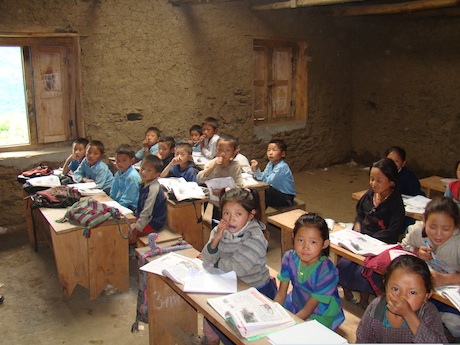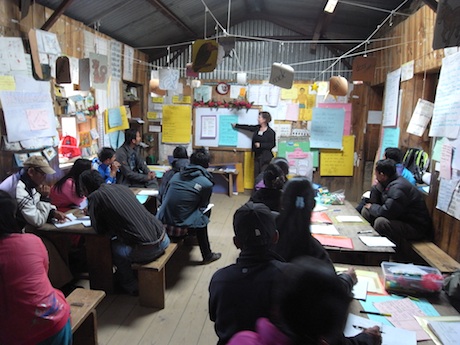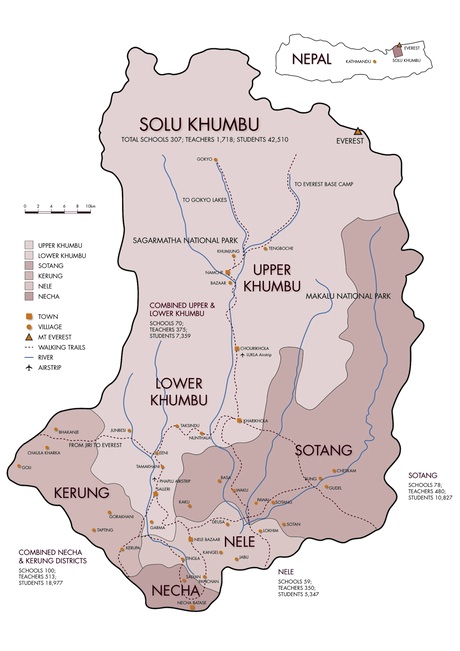The funding received from the Footprints program from this period is integrated into our 3-year quality education program in the Nele district. In 2013 the program continued to form part of an ambitious program to improve the education of the vast Solu Khumbu region of Nepal with over 35,000 children and over 1700 teachers in 307 schools that extend from the impoverished foothills to the base of Mt Everest.
The Footprints program is helping to improve the education of approx. 5500 children, 350 teachers in 59 schools in the Nele district, which is part of the Solu Khumbu region. Unlike its more prosperous Sherpa communities that live beneath of the shadow of Everest, Sotang is in dire need of support. Educational facilities are basic with some schools accommodating up to 100 children in one classroom, where teachers have little or no training and where children regard textbooks as a luxury. It is therefore not surprising that educational outcomes are among the lowest in Nepal.
There have been significant ongoing challenges in improving the level of teacher training in rural communities. These include:
Activities in Nele provide part of an overall 12-year program in the Solu Khumbu region. Following the completion of the Nele district the program will continue in the Necha/Kerung districts in July 2014. To ensure the sustainability of the program and improve educational standards further refresher training and key teacher training workshops will continue and further educational resources supplied to the Nele district.
‘The only load a child should carry is their school bag’.
In Nepal, children as young as 11 carry heavy loads for days at a time and have no chance of receiving the benefits of a basic education. The Australian Himalayan Foundation's Quality Education program, operating in one of the poorest regions of rural Nepal, helps ensure that all children have access to primary education. It is closely aligned to U.N Millennium Development Goal 2, that all primary school children should have access to full time education.

Photo: Supporting schools in the remote region of the Lower Solu Khumbu
'Quality Education' Project background
This far reaching program extends educational opportunities beyond the well resourced Upper Solu Khumbu region in the vicinity of Mt Everest and focuses on the impoverished districts of the Lower Solu Khumbu that are in dire need of educational support.
The key challenge facing education in rural districts of Nepal is not building more schools but improving the quality of the education delivered, so children are equipped with the kind of education that changes lives.
The Quality Education program aims to help over 42,000 children and 1700 teachers in over 300 schools.
With the support of funding from the Footprints Network over the years, acheivements include the training of 1050 teachers in over 200 schools resulting in:
- Increased primary school attendance
- Increased girls enrolment rates
- Increased retention rates of students through to secondary school
The program also includes support for Key Teacher workshops designed to fast track the most able teachers so that they can eventually train other teachers – creating a truly sustainable program. The AHF has to date trained over 55 local teachers in the region who have now become teacher trainers themselves.

Photo: Australian volunteer trains local Nepalese teachers
Program activities and aims
The Quality Education program is conducted throughout the year and includes a series of workshops that include:
- Key teacher training – to train gifted teachers to train other teachers in the region
- Refresher teacher training – to provide additional training to teachers who have already attended the main teacher training workshops
- Primary teacher training – to provide initial training for inexperienced teachers who have only completed a rudimentary education
- Community Support workshops – to ensure community involvement and support that is vital to the long term outcomes of the program
Educational issues in this region of Nepal
The Solu Khumbu region comprises of five districts – the Khumbu (Everest region), and the more impoverished regions Sotang, Nele, Necha and Kerung to the south - see map below.

In the impoverished and remote regions of Solu Khumbu there are very limited opportunities for children. With an appropriate education strategy that includes support for community support (vital for attendance), social cohesion and local involvement in schools, there is an inevitable increase in children regularly attending and remaining in school.
Community Involvement
The Quality Education program is run hand in hand with the local community partners and experienced volunteers, ensuring sustainable benefits and increased community support. This program is jointly led by a group of highly experienced teacher trainer co-ordinators; AHF in-country partners in Nepal and a small team of Australian volunteer teacher trainers.
Can I visit this project?
Australian teachers (and other nationalities) can participate as volunteer Teacher Trainers as well as helping with general teacher training. Please contact us at [email protected] if you are interested in volunteering.
In March 2014, we will be leading a trek in partnership with World Expeditions to visit our schools in the Lower Solu Khumbu and we would love you to join us. Read more about our Treks for Change here.
This is the 100th project to help end poverty being funded by The Footprints Network. Thank you everyone for your micro-donations - even small things can create big change.